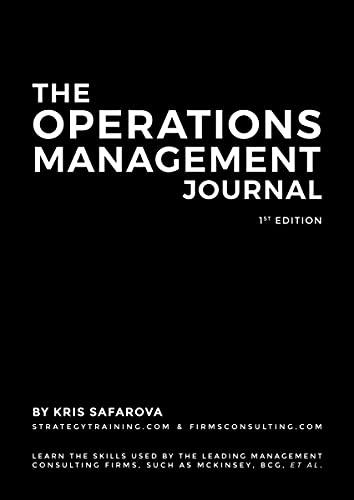Answered step by step
Verified Expert Solution
Question
1 Approved Answer
1. The belief that an individual's behavior leads to specific outcomes and their evaluation of the outcomes is the A. attitude toward the outcome. B.
| 1. The belief that an individual's behavior leads to specific outcomes and their evaluation of the outcomes is the |
| A. attitude toward the outcome. |
| B. subjective norm. |
| C. attitude toward the behavior. |
| D. deterrent of goal pursuit. |
| 2. Which of the following factors can have a negative effect on a consumer's evaluation of a store and the products offered? |
| A. Aromatic smells |
| B. Noise |
| C. Visual displays |
| D. Music |
| 3. An IT company launched a new product for its targeted market in early 2021. After one year, consumers are starting to accept the product. The length of time it has taken to be accepted is referred to as the |
| A. rate of adoption. |
| B. strength of innovativeness. |
| C. frequency of usage. |
| D. frequency of purchase. |
| 4. Robert enjoys the thrill of participating in adventurous and intense activities such as skydiving and mountain climbing. He is considered a |
| A. general-sensation seeker. |
| B. optimal-sensation seeker. |
| C. low-sensation seeker. |
| D. high-sensation seeker. |
| 5. Desired behavior that's rewarded occasionally is on a/an |
| A. continuous reinforcement schedule. |
| B. intermittent reinforcement schedule. |
| C. reinforcement schedule. |
| D. practice reinforcement schedule. |
| 7. Which of the following disciplines contributes to consumer behavior by providing insight into how consumers relate to other people and function within groups? |
| A. Anthropology |
| B. Psychology |
| C. Sociology |
| D. Social psychology |
| 8. Which of the following options allows companies to enhance their relationship with their customers? |
| A. Consumer behavior management |
| B. Customer touchpoint management |
| C. Relationship development management |
| D. Customer relationship management |
| 9. Under operant conditioning, what's necessary to cause a behavioral change and increase the chances of it being repeated in the future? |
| A. Manipulation |
| B. Reinforcement |
| C. Habit |
| D. Stimulation |
| 10. The most common basis for segmenting consumer markets is by |
| A. geography. |
| B. economics. |
| C. demographics. |
| D. preference. |
| 11. Which of the following options is not a household segmentation system offered by PRIZM? |
| A. ConneXions |
| B. PRIZM Premier |
| C. TRENDS |
| D. P$YCLE |
| 12. How does a consumer behavior analysis impact marketers? |
| A. It reveals the strategies, products, and services of competitors in the industry. |
| B. It helps managers set wages for sales professionals. |
| C. It prevents companies from maintaining accurate inventory levels because of data validity issues. |
| D. It helps predict how consumers respond to product and service marketing tactics. |
| 13. Amy has started practicing yoga and is pleased with the positive mental and physical effects she feels. Her motivation to continue practicing is |
| A. extrinsic. |
| B. intrinsic. |
| C. emotional. |
| D. rational. |
| 14. Which of the following innovations was the driving force behind e-commerce? |
| A. Web browser |
| B. Mail advertising |
| C. Television |
| D. Cell phone technology |
| 15. The assumption that people who live within the same neighborhood are likely to purchase the same products and services is a concept of |
| A. geodemographic segmentation. |
| B. behavioral segmentation. |
| C. gender segmentation. |
| D. psychographic segmentation. |
| 16. How do marketers combat selective exposure when targeting consumers? |
| A. They routinely use the same ad and exposure method so consumers can eventually encounter the ad. |
| B. They place ads in as many places as possible in hopes of reaching more individuals. |
| C. They consistently modify ads to capture more consumers' attention for the same product. |
| D. They use selective ad placement, so their targeted consumers are more likely to encounter them. |
| 17. Feelings of like or dislike are a part of which of the following components of an attitude? |
| A. Affective |
| B. Behavioral |
| C. Cognitive |
| D. Conative |
| 18. If a marketer is attempting to employ tactics that aid in enhancing consumers' memories of positive product attributes, the tactics must |
| A. enhance their mood. |
| B. saturate the environment with information. |
| C. mimic what competitors are doing. |
| D. provide various product options to choose from. |
| 19. A consumer's beliefs about a product can be based on knowledge, opinion, or their value systems. This stems from which of the following components of a traditional model of attitudes? |
| A. Conative |
| B. Behavioral |
| C. Cognitive |
| D. Affective |
| 20. A consumer's passion that involves the longing and yearning for something is considered a | ||||
|
Step by Step Solution
There are 3 Steps involved in it
Step: 1

Get Instant Access to Expert-Tailored Solutions
See step-by-step solutions with expert insights and AI powered tools for academic success
Step: 2

Step: 3

Ace Your Homework with AI
Get the answers you need in no time with our AI-driven, step-by-step assistance
Get Started


